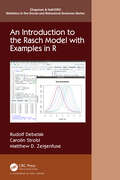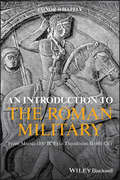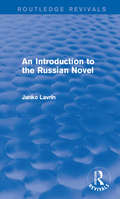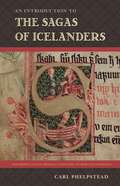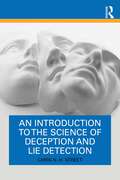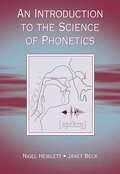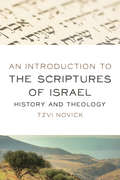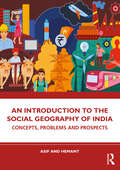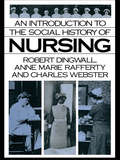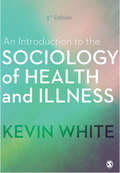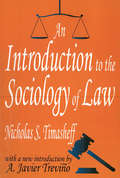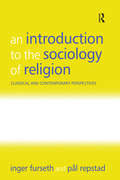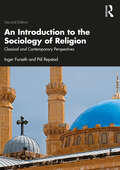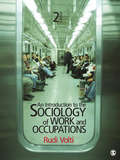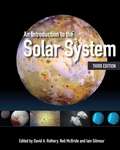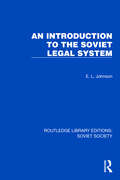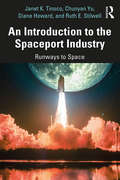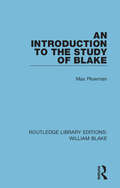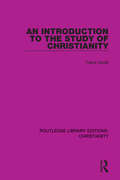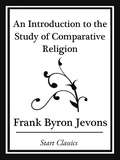- Table View
- List View
An Introduction to the Rasch Model with Examples in R (Chapman & Hall/CRC Statistics in the Social and Behavioral Sciences)
by Rudolf Debelak Carolin Strobl Matthew D. ZeigenfuseAn Introduction to the Rasch Model with Examples in R offers a clear, comprehensive introduction to the Rasch model along with practical examples in the free, open-source software R. It is accessible for readers without a background in psychometrics or statistics, while also providing detailed explanations of the relevant mathematical and statistical concepts for readers who want to gain a deeper understanding. Its worked examples in R demonstrate how to apply the methods to real-world examples and how to interpret the resulting output. In addition to motivating and presenting the Rasch model, the book covers different methods for parameter estimation and for assessing fit and differential item functioning (DIF). While focusing on the Rasch model, it also addresses a variety of other dichotomous and polytomous Rasch and item response theory (IRT) models, such as two-parameter logistic (2PL) and Partial Credit models, and extensions, including mixture Rasch models and computerized adaptive testing (CAT). Theory is presented in a self-contained way. All necessary mathematical and statistical background is contained in the chapters and appendices. The book also provides detailed, step-by-step instructions for getting started with R and using the eRm, mirt, TAM and rstan packages for fitting Rasch models.
An Introduction to the Roman Military: From Marius (100 BCE) to Theodosius II (450 CE)
by Conor WhatelyFollows the military lives of three soldiers across the Roman world, providing interesting, historical insight into the Roman military from the late republic to the end of antiquity in the west This book introduces readers to three historical Roman soldiers—Titus Pullo from the late republic, Aurelius Polion from the high imperial era, and Flavius Aemilianus from late antiquity. The three men inspire the themes and chronological organization of the text. Drawing on a wide and diverse body of evidence, the author charts their lives from enlistment to death or retirement, allowing students to envision the life of a Roman soldier who is on duty or experiencing adventures across the Roman world. An Introduction to the Roman Military: From Marius (100 BCE) to Theodosius II (450 CE) starts with a historical overview before introducing readers to the Roman soldier. It covers such things as the military hierarchy, soldierly origins, recruitment and training, and the soldier’s appearance and identity. The next section looks at the Roman military during war—its environment, strategies, campaigns, and enemies. Their existence during times of peace follows that and focuses on how soldiers celebrated victory, mourned defeat, and readjusted to civilian life after a war. The book also features a timeline for readers to follow, as well as two glossaries—one filled with Roman military terms and the other with important names and events. · Authentically captures the experiences of Roman soldiers · Educates undergraduate or graduate students on Roman military history · Describes Roman soldiers based on legal, epigraphic, and archaeological evidence · Emphasizes the human side of the Roman military · Moves through three Roman historical periods—the late republic, high imperial, and late antiquity An Introduction to the Roman Military is an engaging choice as a text for specific courses on the Roman military or army. It is also suitable for more general courses covering ancient warfare. In addition to university students, researchers and history enthusiasts will have the opportunity to follow the military lives of three Roman soldiers with this unique book.
An Introduction to the Russian Novel (Routledge Revivals)
by Janko LavrinIn this book, first published in 1943, Janko Lavrin provides an overview of the development of the Russian novel by placing the great Russian novelists – Tolstoy, Dostoevsky, Turgenev, Gorky, Gogol – in relation to their native literature and their social, political and cultural backgrounds. An Introduction to the Russian Novel will appeal particularly to students of Russian literature and culture as well as those interested in the development of the novel in general.
An Introduction to the Sagas of Icelanders (New Perspectives on Medieval Literature: Authors and Traditions)
by Carl PhelpsteadCombining an accessible approach with innovative scholarship, An Introduction to the Sagas of Icelanders provides up-to-date perspectives on a unique medieval literary genre that has fascinated the English-speaking world for more than two centuries. Carl Phelpstead draws on historical context, contemporary theory, and close reading to deepen our understanding of Icelandic saga narratives about the island’s early history. Phelpstead explores the origins and cultural setting of the genre, demonstrating the rich variety of oral and written source traditions that writers drew on to produce the sagas. He provides fresh, theoretically informed discussions of major themes such as national identity, gender and sexuality, and nature and the supernatural, relating the Old Norse-Icelandic texts to questions addressed by postcolonial studies, feminist and queer theory, and ecocriticism. He then presents readings of select individual sagas, pointing out how the genre’s various source traditions and thematic concerns interact. Including an overview of the history of English translations that shows how they have been stimulated and shaped by ideas about identity, and featuring a glossary of critical terms, this book is an essential resource for students of the literary form. A volume in the series New Perspectives on Medieval Literature: Authors and Traditions, edited by R. Barton Palmer and Tison Pugh
An Introduction to the Science of Cosmology (Series in Astronomy and Astrophysics)
by Derek Raine E. G. ThomasA thorough introduction to modern ideas on cosmology and on the physical basis of the general theory of relativity, An Introduction to the Science of Cosmology explores various theories and ideas in big bang cosmology, providing insight into current problems. Assuming no previous knowledge of astronomy or cosmology, this book takes you beyond introductory texts to the point where you are able to read and appreciate the scientific literature, which is broadly referenced in the book. The authors present the standard big bang theory of the universe and provide an introduction to current inflationary cosmology, emphasizing the underlying physics without excessive technical detail.The book treats cosmological models without reliance on prior knowledge of general relativity, the necessary physics being introduced in the text as required. It also covers recent observational evidence pointing to an accelerating expansion of the universe. The first several chapters provide an introduction to the topics discussed later in the book. The next few chapters introduce relativistic cosmology and the classic observational tests. One chapter gives the main results of the hot big bang theory. Next, the book presents the inflationary model and discusses the problem of the origin of structure and the correspondingly more detailed tests of relativistic models. Finally, the book considers some general issues raised by expansion and isotropy. A reference section completes the work by listing essential formulae, symbols, and physical constants.Beyond the level of many elementary books on cosmology, An Introduction to the Science of Cosmology encompasses numerous recent developments and ideas in the area. It provides more detailed coverage than many other titles available, and the inclusion of problems at the end of each chapter aids in self study and makes the book suitable for taught courses.
An Introduction to the Science of Deception and Lie Detection
by Chris N. StreetThis accessible book provides a foundational understanding of the science of deception and lie detection. Focusing on core issues for the field, it discusses classic and current psychological research into lying as well as theoretical approaches to understanding human lie detection. This book explores engaging questions around how people lie, how people make decisions about believing others, and how we can detect deception. Each chapter is clearly structured to support students of all levels by summarising content, presenting key research, and systematically evaluating findings. Chapters explore topics including some of the most promising current lie detection techniques, how and why people lie, how lying develops in children, and whether unconscious thinking can boost lie detection accuracy. Providing an overview of key issues in deception, this book will be of great interest to students and lecturers in the field of deception and lie detection, as well as anyone generally interested in this fascinating field of research.
An Introduction to the Science of Phonetics
by Nigel Hewlett Janet Mackenzie BeckThe book is designed as an introduction to the scientific study of speech. No prior knowledge of phonetics is assumed. As far as mathematical knowlege is concerned, all that is assumed is a knowledge of simple arithmetic and as far as possible concepts are dealt with on an intuitive rather than mathematical level. The anatomical material is all fully explained and illustrated. The book is arranged in four parts. Part 1, Basic Principles, provides an introduction to established phonetic theory and to the principles of phonetic analysis and description, including phonetic transcription. Part 2, Acoustic Phonetics, considers the physical nature of speech sounds as they pass through the air between speaker and hearer. It includes sections on temporal measurement, fundamental frequency, spectra and spectrograms. Part 3, Auditory Phonetics, covers the anatomy of the ear and the perception of loudness, pitch and quality. The final part, Part 4, covers the articulatory production of speech, and shows how experimental techniques and tools can enhance our understanding of the complexities of speech production. Though the audience for this book is mainly students and professors in the Speech Sciences, it will also be valuable to any students studying hearing science and acoustics. The book is well supported with figures, tables, and practice boxes with experiments.
An Introduction to the Scriptures of Israel: History and Theology
by Tzvi NovickIn this distinctive textbook for Hebrew Bible courses, author Tzvi Novick&’s approach is thematic rather than chronological. Sorting the books according to their historical context, theological claims, and literary conventions, Novick examines and elucidates the historical and intellectual development of the Hebrew Bible. With attentiveness to both historical-critical and traditional-canonical approaches, An Introduction to the Scriptures of Israel focuses on the dichotomy of the particular and the universal. It shows how this dichotomy impacts each book&’s style and content and how it informs the development of Jewish and Christian traditions. This nontraditional textbook is coherent, engaging, and succinct—a perfect resource for any introductory Hebrew Bible course.ContentsPreface Abbreviations 1. Three Introductions 2. The Wisdom Tradition: Religion without Revelation 3. Revelation and Love: The Patriarchal Narratives and the Song of Songs 4. Joseph and Narrative 5. The Exodus: Freedom and Sonship 6. Sinai: Covenant and Code 7. The Problem of Monarchy: Samuel and Kings 8. Condemning Israel, Sparing the Nations: Amos and Jonah 9. Eden and the Art of Reading 10. Priestly Theology and Holy Space 11. Exile and Return: Prophetic Visions 12. The Consolidation of Judaism: Temple and Torah 13. Violence and Identity: Joshua and Judges 14. Jews, Gentiles, and Gender: Esther, Ruth, Ezra, and Nehemiah 15. Apocalyptic: Daniel and the Dead Sea Scrolls 16. The Israelite at Prayer: The Book of PsalmsSubject Index Scripture and Other Ancient Sources Index
An Introduction to the Scriptures of Israel: History and Theology
by Tzvi NovickIn this distinctive textbook for Hebrew Bible courses, author Tzvi Novick&’s approach is thematic rather than chronological. Sorting the books according to their historical context, theological claims, and literary conventions, Novick examines and elucidates the historical and intellectual development of the Hebrew Bible. With attentiveness to both historical-critical and traditional-canonical approaches, An Introduction to the Scriptures of Israel focuses on the dichotomy of the particular and the universal. It shows how this dichotomy impacts each book&’s style and content and how it informs the development of Jewish and Christian traditions. This nontraditional textbook is coherent, engaging, and succinct—a perfect resource for any introductory Hebrew Bible course.ContentsPreface Abbreviations 1. Three Introductions 2. The Wisdom Tradition: Religion without Revelation 3. Revelation and Love: The Patriarchal Narratives and the Song of Songs 4. Joseph and Narrative 5. The Exodus: Freedom and Sonship 6. Sinai: Covenant and Code 7. The Problem of Monarchy: Samuel and Kings 8. Condemning Israel, Sparing the Nations: Amos and Jonah 9. Eden and the Art of Reading 10. Priestly Theology and Holy Space 11. Exile and Return: Prophetic Visions 12. The Consolidation of Judaism: Temple and Torah 13. Violence and Identity: Joshua and Judges 14. Jews, Gentiles, and Gender: Esther, Ruth, Ezra, and Nehemiah 15. Apocalyptic: Daniel and the Dead Sea Scrolls 16. The Israelite at Prayer: The Book of PsalmsSubject Index Scripture and Other Ancient Sources Index
An Introduction to the Social Geography of India: Concepts, Problems and Prospects
by Asif Ali HemantThis book discusses the significance of social geography, a multidimensional sub-discipline of georgraphy encompassing social health, social security and social ethos. It presents the socio-spatial dynamics of the population in India through an understanding of the various issues related to migration, urbanisation, unemployment, poverty and public health. With a thorough analysis of various social indicators relating to health, education, income and employment, the volume presents a detailed picture of the social geography of India. It discusses in detail, The origin, nature and scope of social geography, its relations with other social sciences and applications The nature and importance of social well-being along with welfare geography and the role of welfare state in ensuring social well-being The population of India and its attributes The status and spatial patterns of various social indicators relating to health, education and income and employment The composite indices which aggregate several social indicators such as the Human Development Index, Multidimensional Poverty Index and Sustainable Developmental Goals Index in the context of India. This comprehensive book will be useful for students, researchers and teachers of social geography, human geography, population geography, demography and sociology. The book can also be used by students preparing for exams like civil services, UPSC, PSC and other competitive exams.
An Introduction to the Social History of Nursing
by Anne Marie Rafferty Robert Dingwall Charles WebsterIn recent years the study of nursing history in Britain has been transformed by the application of concepts and methods from the social sciences to original sources. The myths and legends which have grown up through a century of anecdotal writing have been chipped away to reveal the complex story of an occupation shaped and reshaped by social and technological change. Most of the work has been scattered in monographs, journals and edited collections. The skills of a social historian, a sociologist and a graduate nurse have been brought together to rethink the history of modern nursing in the light of the latest scholarship. The account starts by looking at the type of nursing care available in 1800. This was usually provided by the sick person's family or household servants. It traces the interdependent growth of general nursing and the modern hospital and examines the separate origins and eventual integration of mental nursing, district nursing, health visiting and midwifery. It concludes with reflections on the prospects for nursing in the year 2000.
An Introduction to the Sociology of Health & Illness
by Dr Kevin WhiteThis is a new edition of the best-selling textbook for students in the Sociology of Health & Illness. The first edition was widely praised for its clarity, accessibility and comprehensive coverage. All of these features are retained in the new edition. Added to them are: * Systematic updated empirical references to the material covered in the first Edition. * A revision of the more challenging elements in the theory section to facilitate comprehension and enhance study. * A consideration of the 'new public management' philosophy in hospital and health care administration. The result is a book that academics and students in the sociology of health and illness will use as a 'first stop' to study. Free of jargon, intuitive about student needs and well versed in course requirements, the new edition will refresh old readers and delight new ones.
An Introduction to the Sociology of Health and Illness
by Kevin WhiteThe bestselling An Introduction to the Sociology of Health and Illness has long been the go-to text for students looking for a clear, engaging and theoretically informed introduction to this dynamic topic. Written with a truly sociological and critical perspective, and thoroughly updated to include the latest cutting-edge thinking in the area, the new edition is packed with new empirical examples. Incorporating helpful learning features including chapter overviews, boxed cases, summaries and further reading, this book is a stimulating and thought-provoking essential text for students in health, nursing and sociology schools.
An Introduction to the Sociology of Health and Illness
by Kevin WhiteThe bestselling An Introduction to the Sociology of Health and Illness has long been the go-to text for students looking for a clear, engaging and theoretically informed introduction to this dynamic topic. Written with a truly sociological and critical perspective, and thoroughly updated to include the latest cutting-edge thinking in the area, the new edition is packed with new empirical examples. Incorporating helpful learning features including chapter overviews, boxed cases, summaries and further reading, this book is a stimulating and thought-provoking essential text for students in health, nursing and sociology schools.
An Introduction to the Sociology of Law
by Nicholas Sergeyevitch TimasheffThe exiled Russian sociologist and legal scholar Nicholas S. Timasheff's place in the forefront of the sociology of law was established with the publication, in 1939, of An Introduction to the Sociology of Law. His magnum opus articulates a systematic legal sociology. The book's title is misleading, giving the false impression that the volume is merely a textbook intended for classroom use. It is much more than this. An Introduction to the Sociology of Law is a sophisticated treatise that explains, precisely and methodically, the law as a social force. It makes two fundamental points: law can, indeed must, be studied by sociology, and law is a combination of socio-ethical and imperative coordination of human behavior.
An Introduction to the Sociology of Religion: Classical and Contemporary Perspectives
by Inger Furseth Pål RepstadIs it true that religion is weakening in modern times, or are we facing religious resurgence? What is fundamentalism? How does it emerge and grow? What role does religion play in ethnic and national conflicts? Is religion a fundamental driving force or do political leaders use religion for their own purposes? Do all religions oppress women? These are some of the questions addressed in this book. An Introduction to the Sociology of Religion provides an overview of sociological theories of contemporary religious life. Some chapters are organized according to topic. Others offer brief presentations of classical and contemporary sociologists from Karl Marx to Zygmunt Bauman and their perspectives on social life, including religion. Throughout the book, illustrations and examples are taken from several religious traditions.
An Introduction to the Sociology of Religion: Classical and Contemporary Perspectives
by Inger Furseth Pål RepstadWhat are religion and nonreligion? How do fundamentalism and religious radicalization emerge and grow? How do social class, gender, sexuality, race, ethnicity, and other factors affect religious beliefs, practices, and organizations? Is religion a fundamental driving force or do political leaders use religion for their own purposes? In exploring these pertinent questions, An Introduction to the Sociology of Religion provides an overview of sociological theories of contemporary religious life. Theoretical discussion is accompanied by presentations of empirical research from several religious traditions in many parts of the world. The sociology of religion is linked closely to developments in general sociology. Some chapters are organized according to topic, while others offer brief presentations of classical and contemporary sociologists from Karl Marx to Patricia Hill Collins and their perspectives on social life, including on religion. This second edition has been thoroughly updated throughout with new chapters on religion and social inequalities, social and religious movements, and extremism. Covering classical sociology of religion as well as contemporary debates and topics, this book is ideal reading for students approaching the sociology of religion for the first time.
An Introduction to the Sociology of Work and Occupations (2nd Edition)
by Rudi VoltiThe Sociology of Work and Occupations, Second Edition connects work and occupations to the key subjects of sociological inquiry: social and technological change, race, ethnicity, gender, social class, education, social networks, and modes of organization. In 15 chapters, Rudi Volti succinctly but comprehensively covers the changes in the world of work, encompassing everything from gathering and hunting to working in today's Information Age. This book introduces students to a highly relevant analysis of society today. In this new and updated edition, globalization and technology are each given their own chapter and discussed in great depth.
An Introduction to the Solar System
by David A. Rothery Iain Gilmour Neil McBrideOngoing advances in Solar System exploration continue to reveal its splendour and diversity in remarkable detail. This undergraduate-level textbook presents fascinating descriptions and colour images of the bodies in the Solar System, the processes that occur upon and within them, and their origins and evolution. It highlights important concepts and techniques in boxed summaries, while questions and exercises are embedded at appropriate points throughout the text, with full solutions provided. Written and edited by a team of practising planetary scientists, this third edition has been updated to reflect our current knowledge. It is ideal for introductory courses on the subject, and is suitable for self-study. The text is supported by online resources, hosted at www.cambridge.org/solarsystem3, which include selected figures from the book, self-assessment questions and sample tutor assignments, with outlines of suggested answers.
An Introduction to the Soviet Legal System (Routledge Library Editions: Soviet Society)
by E.L. JohnsonAn Introduction to the Soviet Legal System (1969) sets the main features of modern Soviet law against their background in Russian legal history and Marxist political thought. Important constitutional provisions are examined in detail and their value in practice considered. In the second part of the book special emphasis is given to those parts of the system most likely to interest the general reader and the non-legal specialist in Soviet affairs. Criminal Procedure and Family Law are considered in detail, as are Trade Unions and the settlement of Labour Disputes. Special features of the Soviet legal system such as the legal position of the State Bank, collective farms and the state-controlled commercial and industrial enterprises are examined. The final chapter is devoted to the work of the Soviet legal profession.
An Introduction to the Spaceport Industry: Runways to Space
by Chunyan Yu Janet K. Tinoco Diane Howard Ruth E. StilwellThis book provides a contemporary look at spaceports, not only from relevant technological drivers, policies, and legal perspectives, but also from impacts associated with airspace use and aviation stakeholders. Economic, business, financial, and environmental considerations; issues facing airports transitioning to air and space ports; and spaceport planning are discussed. Through case and event studies, research and analysis, along with information obtained through professional experience, this book provides an overview of the many benefits, unique challenges, and issues facing commercial spaceports and spaceport operators. Each chapter is a standalone key topic such that the reader can focus on the most compelling issues relevant for them or can view the book as an integrated whole for a full perspective. While examples and case studies come largely from the United States, the reader can draw conclusions that are independent of country and situation. Information on other nation-state policies and advancements, among other topics, is provided to give a global perspective, further expanding the relevancy and benefits of the book to both domestic and international audiences. An Introduction to the Spaceport Industry: Runways to Space fills a gap in the literature, providing professionals, government officials, researchers, professors, and students deep insights into the fast-growing commercial spaceport industry.
An Introduction to the Standard Model of Particle Physics
by W. N. Cottingham D. A. GreenwoodThe new edition of this introductory graduate textbook provides a concise but accessible introduction to the Standard Model. It has been updated to account for the successes of the theory of strong interactions, and the observations on matter-antimatter asymmetry. It has become clear that neutrinos are not mass-less, and this book gives a coherent presentation of the phenomena and the theory that describes them. It includes an account of progress in the theory of strong interactions and of advances in neutrino physics. The book clearly develops the theoretical concepts from the electromagnetic and weak interactions of leptons and quarks to the strong interactions of quarks. Each chapter ends with problems, and hints to selected problems are provided at the end of the book. The mathematical treatments are suitable for graduates in physics, and more sophisticated mathematical ideas are developed in the text and appendices.
An Introduction to the Study of Blake (Routledge Library Editions: William Blake #5)
by Max PlowmanFirst published in 1927 (this edition in 1967), this book is about Blake, his symbols, and their meanings. As Ward says in his forward, the volume goes beyond Blake, becoming universal and timeless, and is about Religion. Plowman’s book presents itself, not as a critical text, but an interpretative one, and the study therefore illuminates the work of the author, as well as that of William Blake.
An Introduction to the Study of Christianity
by Frank DoddOriginally published in 1938, An Introduction to the Study of Christianity is a consideration of what is truly essential in the Christian faith. The book provides a detailed survey of key elements relating to the origin and growth of Christianity, and puts forward the argument that any apparent blemishes or mistakes are the result of human imperfection and misunderstanding of the real teaching of Jesus and his immediate followers, rather than of any shortcomings in the teaching itself. It first sets out the foundations of Christianity and then calls attention to the different interpretations that successive generations of Christians have placed on them. Exploring the history of the Christian faith up to the 1930s, An Introduction to the Study of Christianity will appeal to those with an interest in the history of religion, Christianity, theology, and religious studies.
An Introduction to the Study of Comparative Religion (Start Classics)
by Frank Byron JevonsThe Hartford-Lamson Lectures on The Religions of the World are delivered at Hartford Theological Seminary in connection with the Lamson Fund, which was established by a group of friends in honor of the late Charles M.Lamson, D.D., sometime President of the American Board of Commissioners for Foreign Missions, to assist in preparing students for the foreign missionary field. The Lectures are designed primarily to give to such students a good knowledge of the religious history, beliefs, and customs of the peoples among whom they expect to labor. As they are delivered by scholars of the first rank, who are authorities in their respective fields, it is expected that in pubUshed form they will prove to be of value to students generally.
